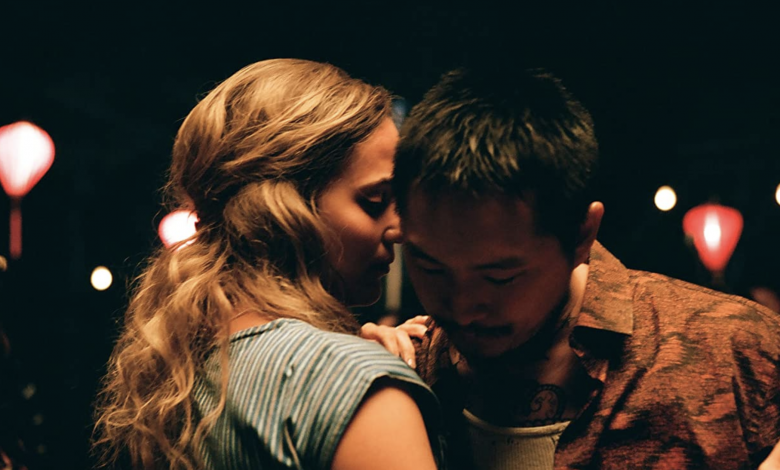Blue Bayou Moves, but Fails to Stick the Landing

Karenna Umscheid ‘25 / Emertainment Monthly Staff Writer
Blue Bayou begins with a lot of promise. There is clearly a lot of heart in the relationships and sweet moments spliced with angering inciting events. There is little subtlety in what this film prepares to emphasize: cultural and family ties. However, potential goes uncharted in explorations of identity and culture, but the film still remains largely coherent until the third act. At that point, storylines become rushed and forgotten, characters make confusing switches in behavior, and suddenly the driving force behind the film becomes muddled and undercut. Blue Bayou certainly pulls emotional strings, but the ending leaves much to be desired.
The shots are beautiful throughout the film, often shaded in blue. Antonio Leblanc (Justin Chon) speeds past bodies of water on his motorcycle. He’s a Korean immigrant, brought to the United States by his parents. They did not fill out the proper paperwork, and it’s revealed he is technically an illegal citizen. His wife, Kathy (Alicia Vikander) is often adorned in soft blue clothing. She has a daughter named Jessie (Sydney Kowalske) who is beloved by Antonio. Jessie’s biological father, Ace (Mark O’Brien), is a police officer. Ace is estranged from Kathy and Jessie and blames Antonio for his inability to see his daughter, even though it is Jessie who does not want to see her father. When Ace, along with his partner, Denny (Emory Cohen) run into Antonio, Kathy, and Jessie, Denny begins to attack Antonio. He pushes him, and as Antonio attempts to fight back and free himself, he is pushed to the ground, beaten, and arrested. The blues of culture and nature become villainized in the blue of ICE uniforms, but the film fails to say anything groundbreaking on law enforcement through its poor writing.
It’s highly metaphorical, draping characters in light blue curtains and spanish moss. It looks stylish, soft, and really quite gorgeous. These shots nearly say something compelling. Shots of Antonio’s birth mother and various aquatic cinematography, adorned with lilies and Spanish moss, begin to explore his identity. If executed correctly, these shots and storyline could have explored the American Dream, being a foreigner, and where familial roots lie. Instead, these potentially poignant storylines were abandoned in favor of shallower exploits and oversaturated fights. Unnecessary depictions of violence seemed to take precedence over more genuine storytelling, provoking emotion only momentarily, but lacking indication of thoughtful writing. Blue Bayou grazed the surface of various interesting themes, opting out of exploring any of them in-depth.
The most disappointing part of the film is the handling of ICE and law enforcement. Rather than target an oppressive system of injustice, it pronounces “good” ICE agents and police officers, separating them from the bad ones. Even worse, Antonio’s ICE agent friend gives a description of his work at the very beginning of the film. Even after this, he continues to be portrayed as a good friend, despite the fact that he upholds daily the system that deports Antonio and tears him from his family. The film goes even more grossly in this territory when it suddenly changes Ace into a good guy, supporting Antonio’s case to avoid deportation despite the fact that he is the reason Antonio was arrested in the first place. Although ICE should be the main villain in this story, the film doesn’t fully commit to this, instead, choosing to separate good and bad agents, rather than the system at-large that separates families.
The most interesting and special part of the film is Antonio’s friendship with Parker (Lin Dam Phan). Meeting by chance in a doctor’s office, they run into each other again on the street where Antonio is handing out flyers for his tattooing business. She reveals her terminal cancer diagnosis, and agrees to get a tattoo of a Fleur de Lis, a flower reminiscent of her past in Vietnam. Although Antonio is in desperate need of money, he refuses to let her pay. They exchange phone numbers, and she invites him to join her family for their monthly dinner.
The gap between being Asian and being Asian-American is very difficult, and Antonio’s identity could have been explored more deeply and meaningfully. Antonio’s family joining Parker’s at a monthly dinner is one of the most interesting and enjoyable scenes of the film, especially because of Alicia Vikander’s gorgeous cover of “Blue Bayou.” The connection between Antonio and Parker examines the generational trauma of being an immigrant and the rehashing of pain and history in the immigration process. Parker tells him she loves water lilies because although it appears they don’t have roots, they do, and they can’t survive without them. Unfortunately, the ending of this storyline feels rather abrupt, forgone in favor of completing others. The beauty and pertinence of this storyline feels undercut and rather forgotten.
The heavily emotional ending of the film doesn’t seem to make a decision on how to end the story. It’s enough to draw audience tears, but post-show pondering brings the poor writing to a forefront. It’s tragic, and in the moment, quite moving. But it’s not successful enough to make a profound impact after the credits roll. Justin Chon’s directing shows a lot of promise, but it was not enough to save a script that failed its story and characters in the third act.